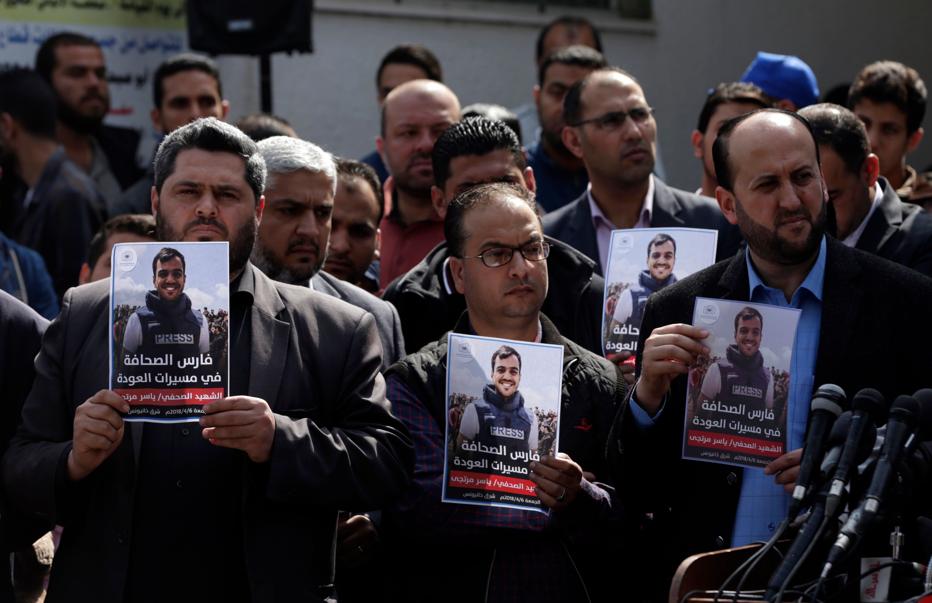
GAZA CITY — Yaser Murtaja had often filmed from the sky, but he never lived to fulfill his dream of flying on an airplane.
The young journalist shot drone images and video for Ain Media, a small Gaza-based news agency he started five years ago. Just two weeks ago, he posted an aerial photo of Gaza City’s port on Facebook, one of his last posts.
‘‘I wish that the day would come to take this shot when I’m in the air and not on the ground,’’ he wrote. ‘‘My name is Yaser Murtaja. I’m 30-years-old. I live in Gaza City. I’ve never traveled!’’
Murtaja, who was married and had a 2-year-old son, died Saturday after being shot the day before by Israeli forces while covering protests at the edge of the Gaza Strip.
He had tried tirelessly to see beyond blockaded Gaza, including to travel for a training course with Al Jazeera in Doha, but he never managed to leave, friends and family said.
Only a tiny proportion of the 2 million Palestinians in Gaza are ever able to get out because of tight travel restriction by Israel — which says such limitations are necessary for security reasons because of the militant group Hamas controlling the area — and only sporadic opening of the Egyptian border.
For many young people, the 140-square-mile strip of territory on the Mediterranean is the only world they know.
Murtaja was laid to rest Saturday in the land he never left, his body carried through the streets of Gaza City draped in a Palestinian flag and the blue-and-white vest marked ‘‘press’’ that he was wearing when he was shot.
Murtaja, who friends and family describe as ambitious and always smiling, was one of nine people killed Friday after Israeli troops used live ammunition as tens of thousands of Palestinians gathered to protest at the heavily guarded boundary with Gaza.
Five other journalists were injured by live fire, as well, according to the Palestinian Journalists’ Syndicate. They were clearly identifiable as journalists, the syndicate said, raising further questions over Israel’s insistence that its use of snipers on the crowds at the border is carefully targeted.
The Israeli military said it fired live rounds in a ‘‘precise measured way’’ as part of its mission to protect Israeli communities near the fence. It said it does not intentionally target journalists and that the circumstances in which the journalists were allegedly hit by Israeli fire were chaotic and ‘‘being looked into.’’
The Palestinian journalists were at the border covering the latest of the six-week-long ‘‘March of Return’’ protests at the border.
The majority of the crowds have been peaceful at the mass rallies, which have drawn first-time demonstrators, as well as families, in what appears to be a wide cross section of Palestinians in Gaza. However, crowds of largely young men nearer to the fence have thrown rocks and Molotov cocktails.
Hamas, which is considered a terrorist group by the United States and Israel, has called on residents to attend, as have other factions in Gaza.
Israel says Hamas is trying to use the demonstrations as a cover to carry out attacks and says shooting is a last resort used to protect its border fence, its soldiers, and Israeli communities from ‘‘violent rioters’’ and attacks.
But the use of live ammunition against the protesters has been widely criticized by human rights groups, who argue it is illegal.
More than 1,000 people — including nearly 400 Friday when a 14-year-old boy was also among those killed — have been shot over the past week, according to the Palestinian health ministry in Gaza.
The Israeli military has said those numbers should be treated with ‘‘extreme caution,’’ but officials have said they cannot confirm whether the numbers are unfeasible compared with the amount of ammunition that has been used.
After the first day of unrest at the border a week ago, the Israel Defense Force’s official spokesman account tweeted that the military knew where ‘‘every bullet landed.’’ However, that post was later deleted.
While the Palestinians’ numbers are difficult to fully verify, accounts of paramedics, medical officials, surgeons, hospital logs, and the sheer pace of gunshot injuries coming from the crowd at points during the protests have all pointed to high figures. Most of those injured with live ammunition were shot in the legs, medics say.
The Israeli military had dropped leaflets in the lead-up to the protest instructing Palestinians to stay at least 300 yards away from the fence and warning live ammunition would be used.
On Friday, thousands of tires were set ablaze, creating a thick black fog that protesters hoped would guard them from the Israeli snipers.
Shady al Assar, 35, who was with Murtaja just before he was shot, said they were around 100 meters from the border at Khan Younes, in the southern Gaza Strip, when he lost sight of his friend in the thick black smoke.
Assar said he picked up his camera to photograph an injured person being carried toward him before realizing it was Murtaja.
Murtaja was wearing a helmet and a protective jacket when he was shot, according to multiple journalists that saw him. However, the bullet entered his side, rendering the protective plates on his front and back useless, they said.



